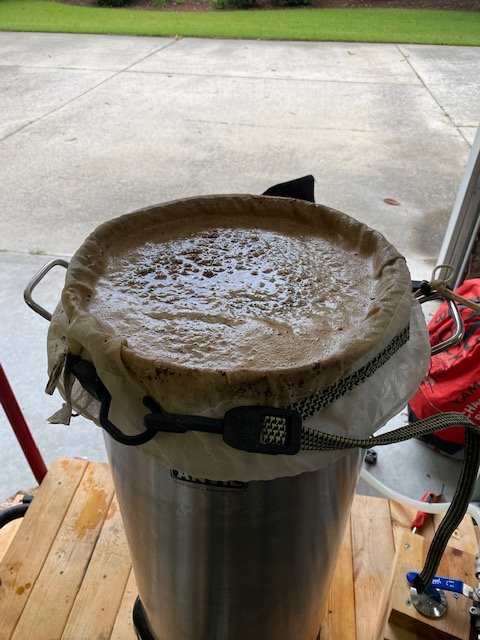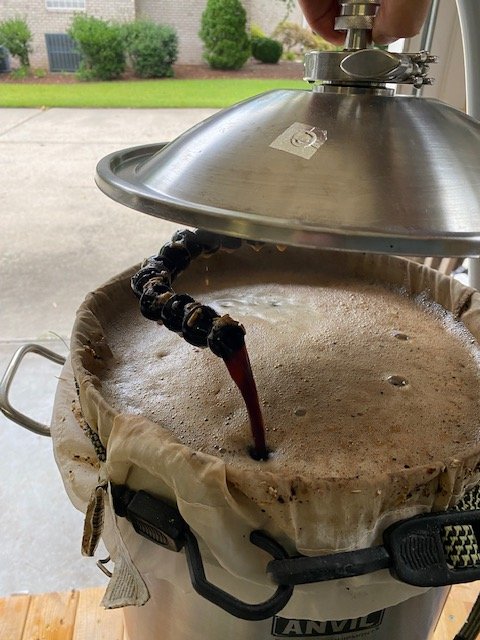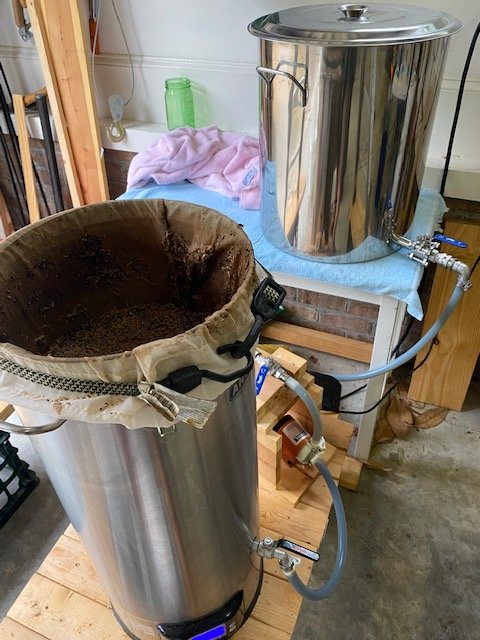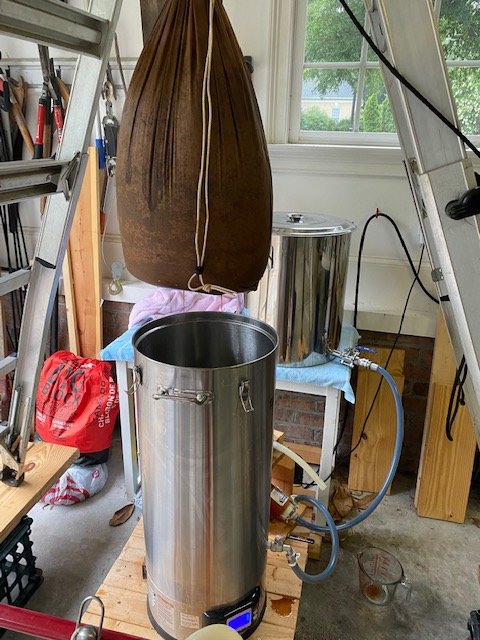Noob_Brewer
Well-Known Member
The Question: when is the most appropriate time to take a refractometer reading to calculate conversion efficiency in all-in-one systems, before or after you lift the malt-pipe?
I am a new brewer having started in january and I have the anvil foundry 10.5g system with recirculation package. I thought at first to post this in one of the foundry threads but thought that since the general designs are similar across all-in-one systems like this, it might reach a broader audience here. After reading countless times by @doug293cz helping people trouble shoot their efficiencies, I started measuring and calculating conversion/lauter efficiencies myself for each batch while beer smith is used to calculate mash/lauter efficiencies.
So heres what I do: 1) I calculate the theoretical Fmax using braukeiser's formula. I then monitor the progress of the mash, refractometer readings, several times throughout the mash duration. I take my final reading right before I lift the malt-pipe and I take another reading after the wort has drained mostly (but before any sparging). I have been calculating the First wort extract (braukeiser terminology) AFTER I lift the malt-pipe but before I sparge to then compare this BRIX reading to the FMAX to calculate conversion efficiency (Fmeasured/Fmax*100). The problem with this with this system is that once you pull the malt-pipe you leave some sugars behind of course and thus the BRIX reading drops slightly. See the attached table I created with the last 4 consecutive brews. You will notice that in beer "C" the brim reading dropped quite a bit. This has happened to me with this drastic of a change 3-4 times before as well. So I started thinking that not only are sugars being left in the grain after pulling the malt-pipe but not all of the water is being mixed with the wort during the mash because of the gap between the malt-pipe and the kettle. I confirmed this issue before by taking a refractometer reading taking the liquid between the malt-pipe and kettle. Its virtually sugarless!
So while taking the BRIX reading AFTER lifting the malt-pipe is suboptimal then taking it before lifting should be better? Well again, if some of the volume of strike water is NOT mixing with the wort inside the malt-pipe then the wort is essentially a thicker water/grist ratio. Again, if you look at "Beer C" in the table below - you will notice that the refractometer reading at the end of the mash before I lifted the malt-pipe was actually higher than the theoretical Fmax. SO this told me that there was likely a lower volume of water mixing with the grains than the total volume of strike water used in the mash and in the calculation of Fmax.
If you look at my mash efficiencies and the general grists that I have been using from the table, I am very happy with the outcomes thus far because mash efficiencies of ~75-78% is pretty good in my book. The reason why Ive wanted to calculate conversion/lauter efficiencies is to help optimize my setup though: and I enjoy being a nerd and taking lots of measurements!
In anticipation of these questions: 1) I do trust my refractometer readings. It is calibrated and validated against my hydrometer readings which I always still take pre-boil and into-the-fermenter. 2) I am super meticulous about achieving my target volumes preboil, post-boil, and into the fermenter. I have made a calibrated measuring stick to help me determine strike volumes and any volumes etc. So I don't think this issue is with erratic differences in volumes (actual vs measured).
So any thoughts on the best way to to estimate First Wort Extract in the calculation of conversion efficiency would be welcome. I have thought of modeling how much water might not be mixing with the wort to reduce the water used in the volume part of Fmax. However, I don't think this is uniform across brews.
Thanks in advance! Also thanks @doug293cz for your thoughtful posts on these issues and posting out braukaisers work!
EDIT: I forgot to add that I have settled on a gap setting of 0.028 using a cereal killer mill and I do use a wilder bag in the malt pipesince I do have a good bit of flower. I also recirculate after the first 10minutes but VERY slowly and I do this only to help maintain mash temps.

I am a new brewer having started in january and I have the anvil foundry 10.5g system with recirculation package. I thought at first to post this in one of the foundry threads but thought that since the general designs are similar across all-in-one systems like this, it might reach a broader audience here. After reading countless times by @doug293cz helping people trouble shoot their efficiencies, I started measuring and calculating conversion/lauter efficiencies myself for each batch while beer smith is used to calculate mash/lauter efficiencies.
So heres what I do: 1) I calculate the theoretical Fmax using braukeiser's formula. I then monitor the progress of the mash, refractometer readings, several times throughout the mash duration. I take my final reading right before I lift the malt-pipe and I take another reading after the wort has drained mostly (but before any sparging). I have been calculating the First wort extract (braukeiser terminology) AFTER I lift the malt-pipe but before I sparge to then compare this BRIX reading to the FMAX to calculate conversion efficiency (Fmeasured/Fmax*100). The problem with this with this system is that once you pull the malt-pipe you leave some sugars behind of course and thus the BRIX reading drops slightly. See the attached table I created with the last 4 consecutive brews. You will notice that in beer "C" the brim reading dropped quite a bit. This has happened to me with this drastic of a change 3-4 times before as well. So I started thinking that not only are sugars being left in the grain after pulling the malt-pipe but not all of the water is being mixed with the wort during the mash because of the gap between the malt-pipe and the kettle. I confirmed this issue before by taking a refractometer reading taking the liquid between the malt-pipe and kettle. Its virtually sugarless!
So while taking the BRIX reading AFTER lifting the malt-pipe is suboptimal then taking it before lifting should be better? Well again, if some of the volume of strike water is NOT mixing with the wort inside the malt-pipe then the wort is essentially a thicker water/grist ratio. Again, if you look at "Beer C" in the table below - you will notice that the refractometer reading at the end of the mash before I lifted the malt-pipe was actually higher than the theoretical Fmax. SO this told me that there was likely a lower volume of water mixing with the grains than the total volume of strike water used in the mash and in the calculation of Fmax.
If you look at my mash efficiencies and the general grists that I have been using from the table, I am very happy with the outcomes thus far because mash efficiencies of ~75-78% is pretty good in my book. The reason why Ive wanted to calculate conversion/lauter efficiencies is to help optimize my setup though: and I enjoy being a nerd and taking lots of measurements!
In anticipation of these questions: 1) I do trust my refractometer readings. It is calibrated and validated against my hydrometer readings which I always still take pre-boil and into-the-fermenter. 2) I am super meticulous about achieving my target volumes preboil, post-boil, and into the fermenter. I have made a calibrated measuring stick to help me determine strike volumes and any volumes etc. So I don't think this issue is with erratic differences in volumes (actual vs measured).
So any thoughts on the best way to to estimate First Wort Extract in the calculation of conversion efficiency would be welcome. I have thought of modeling how much water might not be mixing with the wort to reduce the water used in the volume part of Fmax. However, I don't think this is uniform across brews.
Thanks in advance! Also thanks @doug293cz for your thoughtful posts on these issues and posting out braukaisers work!
EDIT: I forgot to add that I have settled on a gap setting of 0.028 using a cereal killer mill and I do use a wilder bag in the malt pipesince I do have a good bit of flower. I also recirculate after the first 10minutes but VERY slowly and I do this only to help maintain mash temps.

Last edited:




















































![Craft A Brew - Safale BE-256 Yeast - Fermentis - Belgian Ale Dry Yeast - For Belgian & Strong Ales - Ingredients for Home Brewing - Beer Making Supplies - [3 Pack]](https://m.media-amazon.com/images/I/51bcKEwQmWL._SL500_.jpg)









